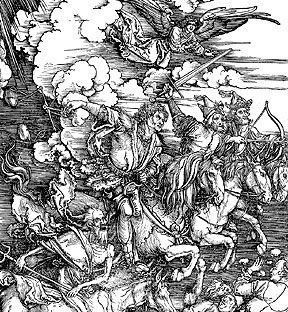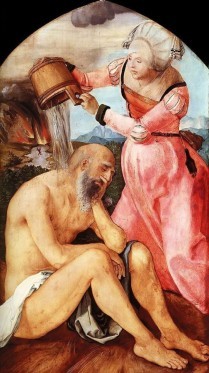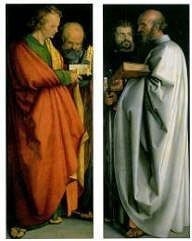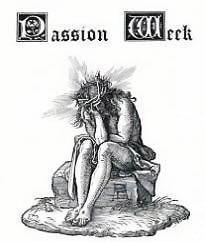Albrecht Durer Free Bible Art Works In High Resolution Images. Choose image for the largest size, then right click to save or print.
Royalty Free
High Resolution Bible Art |

The Four Horsemen of the Apocalypse, 1497 |
"The Four Horsemen Of
The Apocalypse"
Of the fifteen woodcuts in a series illustrating the Apocalypse by Durer, this one of "The Four Horsemen" is the most celebrated. It represents the vision described by St. John in the 6th chapter of Revelation.
"For simple grandeur", writes Professor Thausing, "this design has never been surpassed. What a vivid impression is produced upon the spectator of the impetuosity of the rush forward, an impression which Durer heightens in a masterly way by showing only the forefronts of the horses. The riders themselves, looking angrily forward, one drawing a bow, another brandishing a sword, the third swinging a pair of scales behind him, wear the fantastic dress of the day. The fourth horseman is Death, with the infernal trident. The downtrodden figures in the foreground represent "the fourth part of the earth" which is to be slain. |
Albrecht Durer 1471 – 1528
The genius of Albrecht Durer may hardly be reckoned without taking into account the place held by the art of engraving in the late fifteenth and early sixteenth centuries. To most critics it is probable that neither his paintings nor his drawings could by themselves have won for Durer the immense popularity and authority he has enjoyed had he not been a master of "the most democratic of the arts", that of engraving. |
Durer had to struggle hard for a living. Painting not paying, he devoted himself in the main to engraving and etching. Strange to say, into this bread-and-butter work he put his best, with the result that "he is the greatest engraver that ever lived", though his painting was much admired by no less a master than Raphael. Camerarius, his intimate friend, writing, a short time after Durer died, says that, contrary to the prevailing impression, "he was not of a melancholy severity nor of a repulsive gravity." His hand was so steady and his touch so fine, we are told, that "one might have sworn that rule, square or compass had been employed to draw lines which he, in fact, drew with the brush, or very often with pencil or pen, unaided by artificial means, to the great marvel of those who watched him." |
In Durer the desire to live was entirely absorbed in the desire to think. He was not a man of action, and the records of his life are filled with accounts of what he saw, what he thought, and what others thought of him coupled with frequent complaints of jealousies and lack of appreciation. "Durer", says Furst, "reflects the religious spirit of Protestantism. His ego looms large in his consciousness, and it is the salvation of the soul rather than the mere expansion of the mind that concerns him." His idea of art was that "it should be employed", to use his own words, "in the service of the Church to set forth the sufferings of Christ and such like subjects, and it should also be employed to preserve the features of men after their death."
The very fact that Durer's contemporaries were so loud in praise of the extraordinary technical skill with which he could draw straight lines without the aid of a ruler, or the astounding legerdemain with which he reproduced every single hair in a curl, touches cerebral cords, rather than heartstrings. |

Job and His Wife, 1504 |
Nevertheless, we have such pictures as "The Four Horsemen of the Apocalypse" and "The Four Apostles", the greatness of which no one denies. Here the mind and hand of the artist were in accord.
The eminence of Albrecht Durer is not only that of a creative artist, but he was, as Cust says, one of the great pioneers of art. Before him, little or nothing had been done north of the Alps to make art a factor in the popular life, and now there is probably no branch of the fine arts which has not been affected in one way or another by his works. He stands, as it were, on the watershed between the Middle Ages and the Renaissance, both in the advancement of art and in the development of the human intellect.
Durer's last years were uneventful, and he seems to have been a good deal of an invalid, but he wrote voluminously on artistic and scientific subjects. His last and greatest work, "The Four Apostles", was painted in 1526. With this Durer seems to have felt that his labors as a painter were done, as during the next year not even a drawing of importance came from his hand. He died on the sixth of April, 1528.
Navigation and Searching – Terms of Use – Contact Us
© 2010-2022 Free Christ Images |





